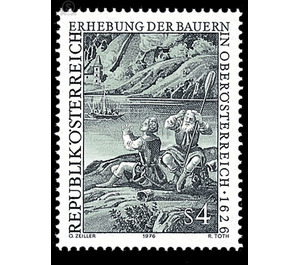Peasants' War 1626 - Austria / II. Republic of Austria 1976 - 4 Shilling
Theme: Art & Culture
| Country | Austria / II. Republic of Austria |
| Issue Date | 1976 |
| Face Value | 4.00 |
| Color | green |
| Printing Type | combination printing |
| Stamp Type | Commemorative |
| Item Type | Stamp |
| Chronological Issue Number | 855 |
| Chronological Chapter | OOS-OE2 |
| SID | 914567 |
| In 68 Wishlists | |
In 1976, exactly 350 years had passed since the great Upper Austrian peasant uprising had devastated almost the entire country over the Enns. A bloody rash between farmers and members of the Bavarian occupying forces stationed at that time in Upper Austria in a tavern near Lembach triggered on 17 May a long-standing uprising of the peasantry. The insurgents won on 21 May a great victory against the occupying army at Peuerbach and brought in the episode almost all of Upper Austria under their control. Only the cities of Linz and Enns could hold the Bavarians. The aim of the uprising was above all the securing of religious freedom and the elimination of Bavarian pawn rule. After the great storm on the city of Linz had failed on 21 July and imperial troops invaded Upper Austria from the east and the north, the insurgents agreed on 10 September 1626 to a truce, which they handed over to the victor at their mercy. The peasants, however, were promised by the Emperor, with the exception of their leaders, to be restored to grace and protected against attacks and plundering of the occupation soldiers. But after the breach of this promise, the rebellion flared up again and could only be bloodily defeated in November 1626. The brand image shows an excerpt from a contemporary engraving on the Siege of Linz.


